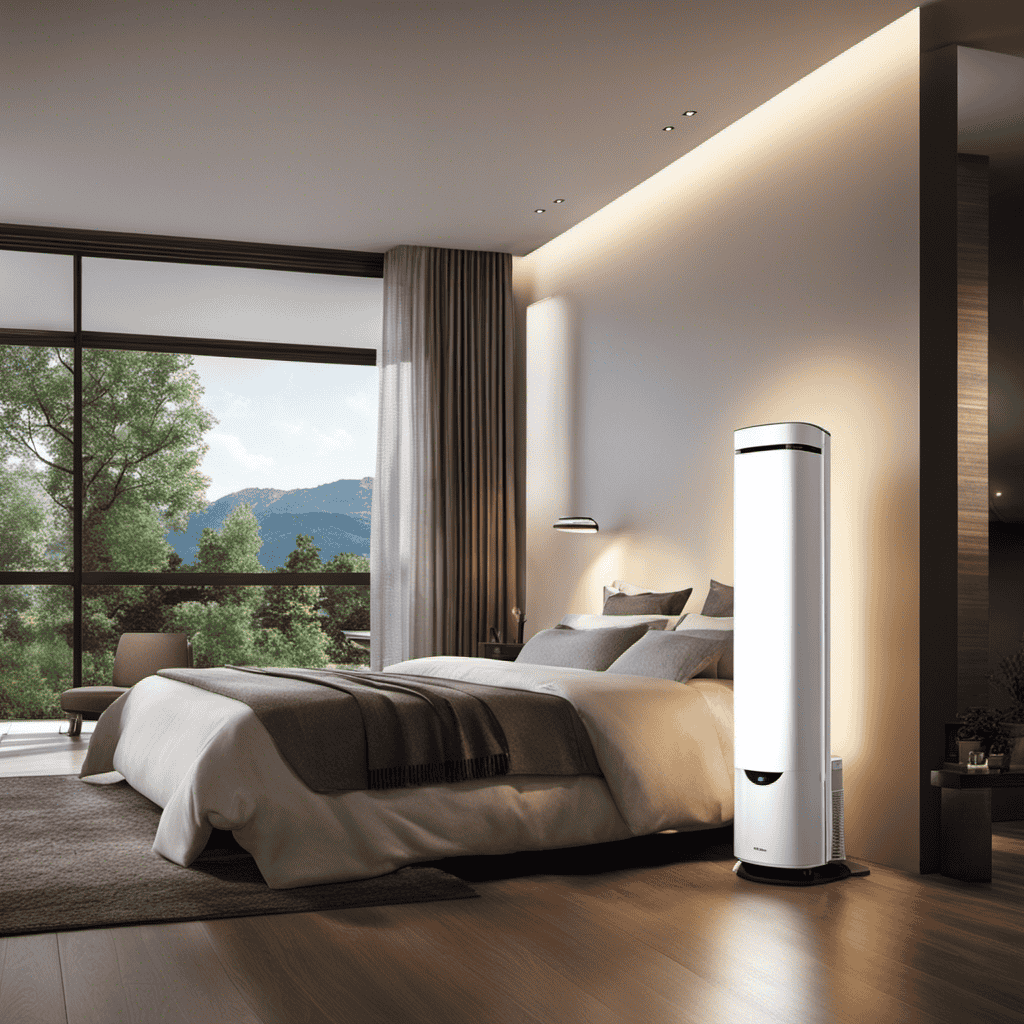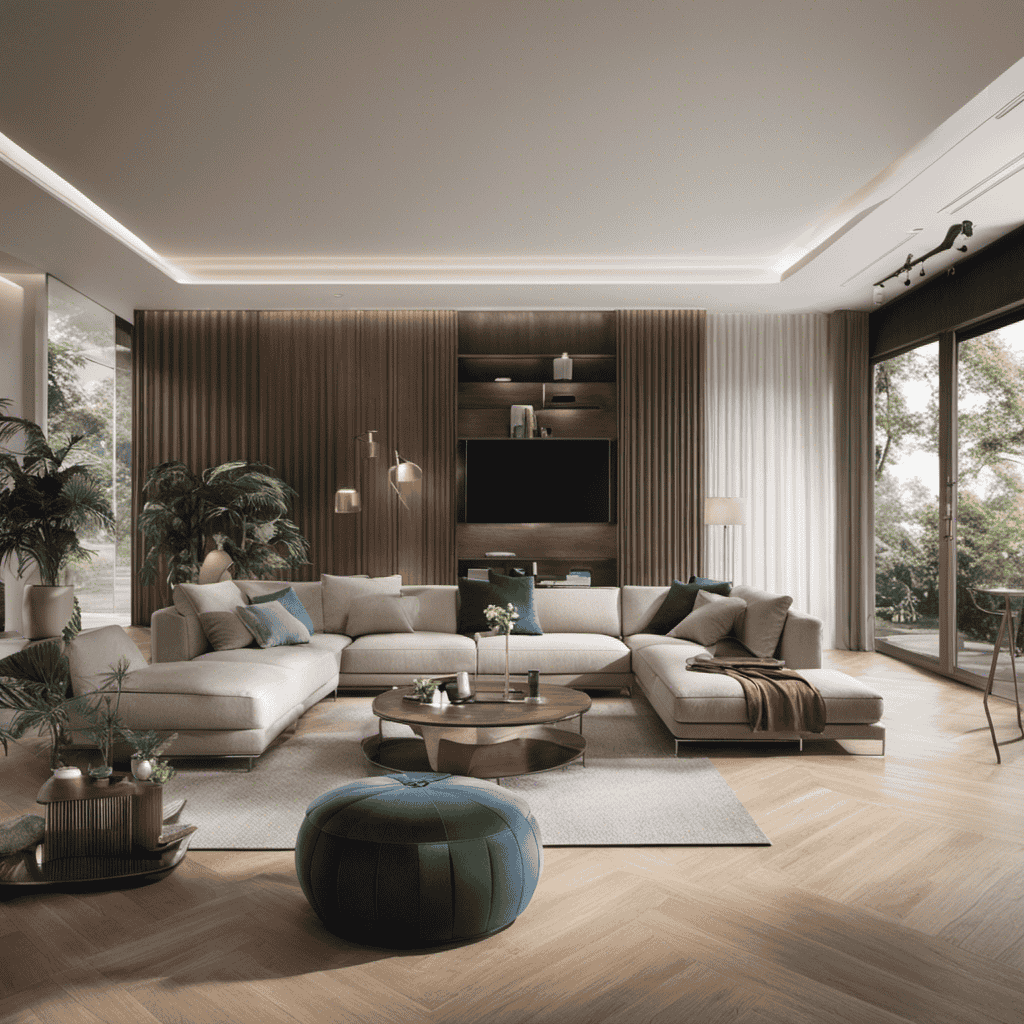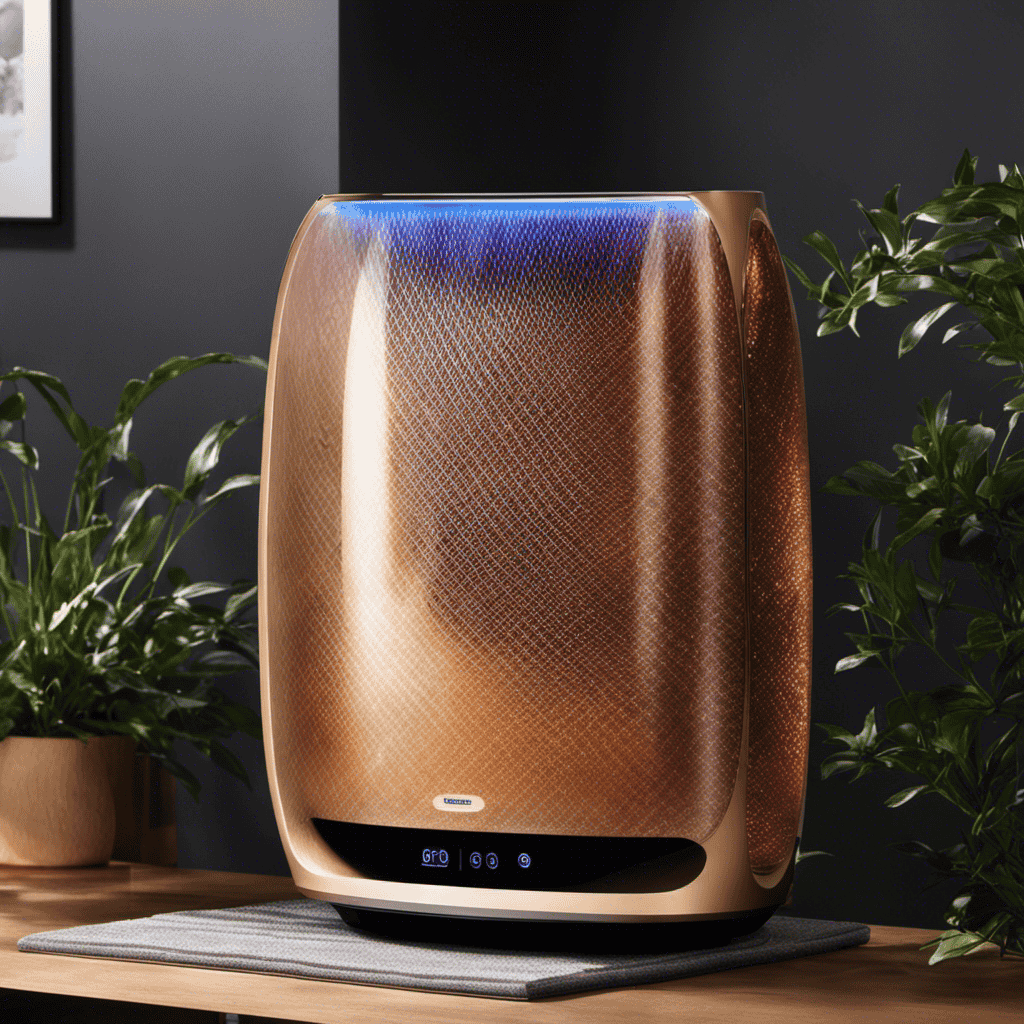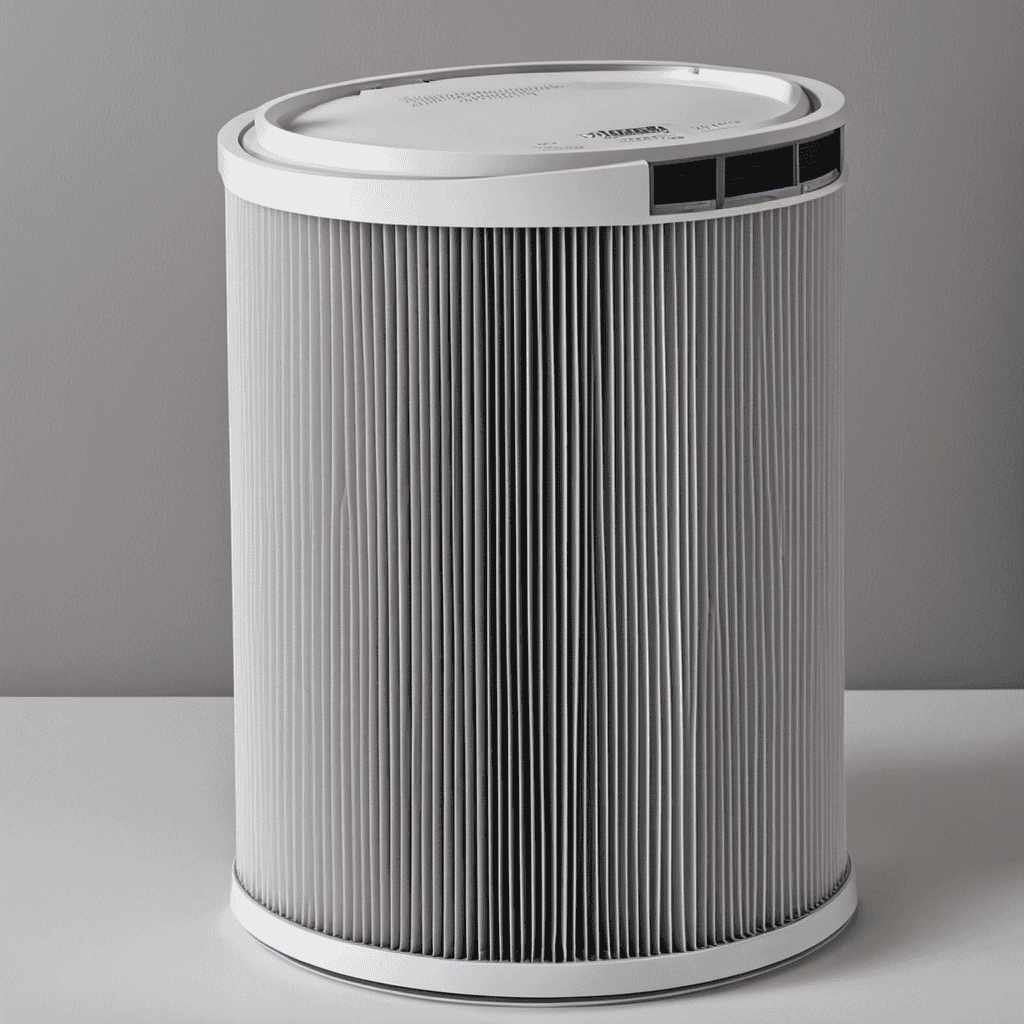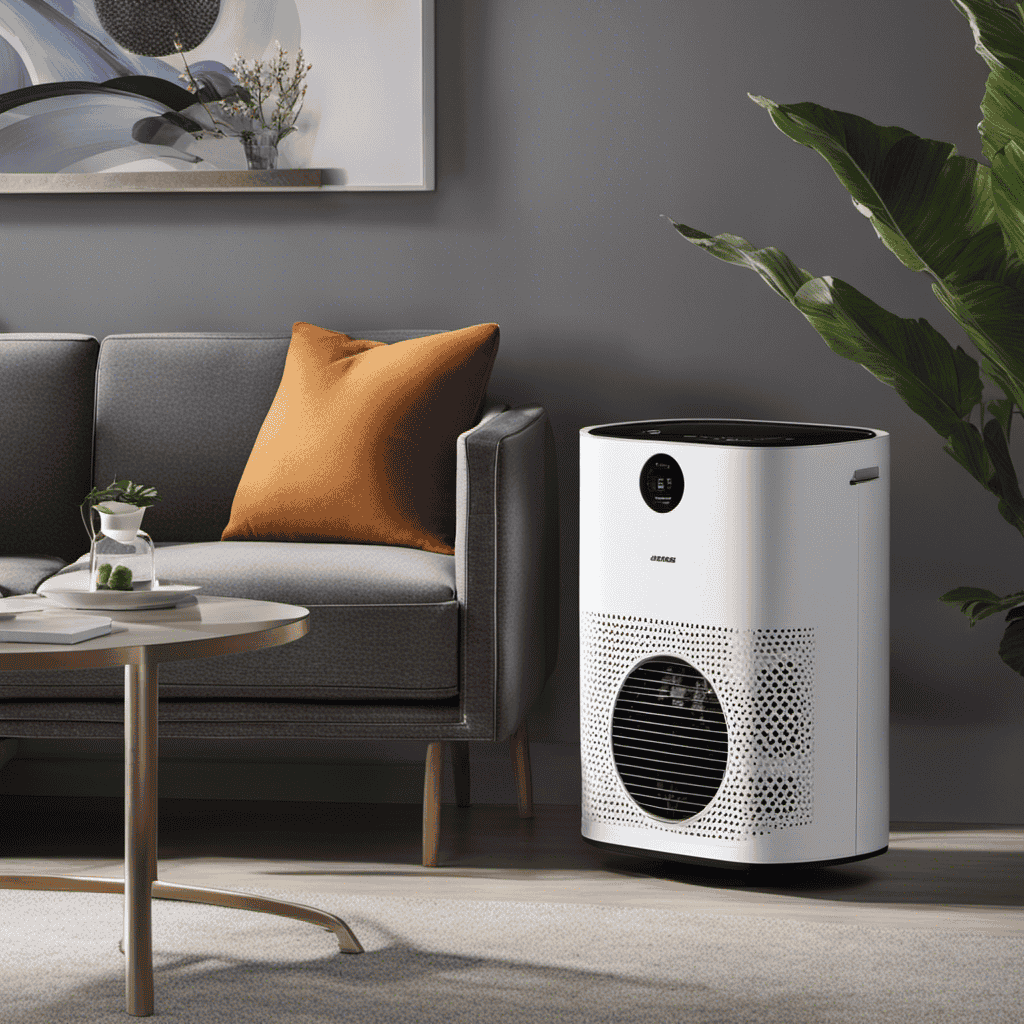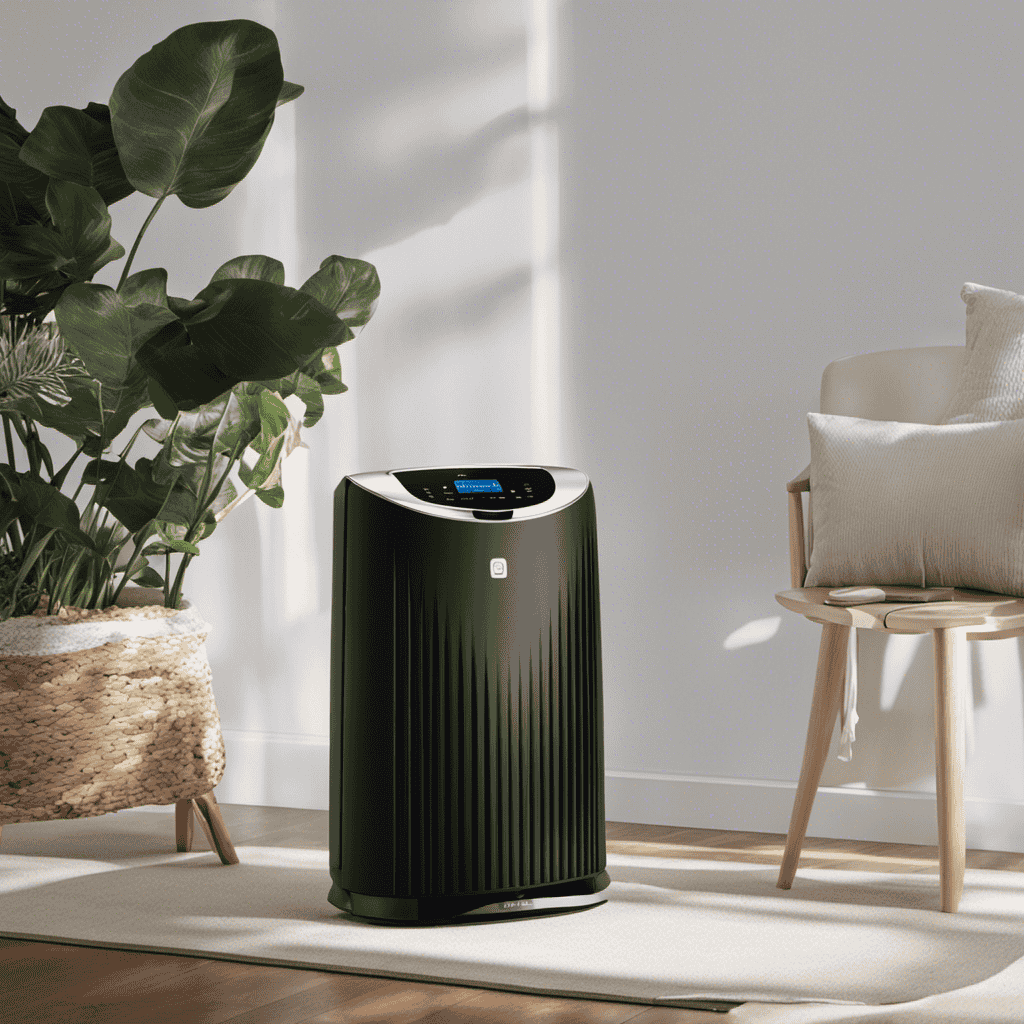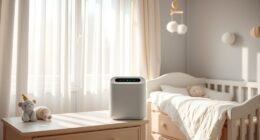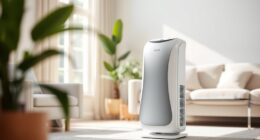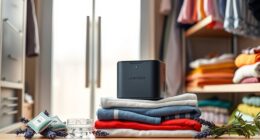As someone who uses an air purifier, I frequently question whether my device is truly effective. Were you aware that indoor air can be up to five times more contaminated than outdoor air? Keeping this concerning fact in mind, it is vital to evaluate the efficiency of an air purifier.
In this article, I will guide you through the essential factors to consider when determining if your air purifier is truly working. From monitoring air quality to measuring the reduction of allergens, we’ll delve into the data-driven techniques that reveal the efficacy of your air purifier.
Key Takeaways
- Monitoring air quality before and after using an air purifier is essential to assess its effectiveness in reducing pollutants.
- Regularly replacing the air filter and maintaining the air purifier’s performance through calibration and cleaning are important for optimal air purification.
- Objective measurement methods, such as particle counters and gas sensors, can be used to evaluate the reduction of particles and specific pollutants.
- Factors like room size, air purifier coverage area, presence of multiple pollution sources, and the type and quality of air filters can affect the performance of an air purifier.
Checking the Air Quality
You can check if the air purifier is working by using an air quality monitor. These devices are designed to measure the levels of pollutants in the air, giving you a clear indication of the effectiveness of your air purifier.
When evaluating energy consumption, it’s important to consider the air purifier’s power usage. Look for models with energy-saving features or adjustable fan speeds to optimize energy efficiency.
Additionally, comparing different air purifier models can help you choose the one that best suits your needs. Consider factors such as the Clean Air Delivery Rate (CADR), which measures the unit’s ability to remove pollutants from the air, and the filter replacement frequency and cost.
Monitoring the Filter Lifespan
Monitoring the filter lifespan in an air purifier can be done by checking the filter replacement indicator. This indicator is designed to measure filter efficiency and track filter replacement, ensuring that the air purifier continues to work effectively.
By regularly monitoring the filter replacement indicator, users can stay informed about when it’s time to replace the filter. This is important because a clogged or dirty filter can significantly reduce the air purifier’s performance, leading to poor air quality.
The filter replacement indicator uses data-driven technology to calculate the remaining lifespan of the filter based on factors such as usage, air quality, and filter type. It provides an accurate estimation, allowing users to proactively replace the filter and maintain optimal air purification.
Assessing the Improvement in Respiratory Symptoms
When it comes to assessing the improvement in respiratory symptoms, three key points need to be considered.
Firstly, symptom tracking accuracy is crucial in order to get reliable data on the progress of respiratory symptoms.
Secondly, objective measurement methods, such as spirometry or peak flow measurements, provide quantitative data that can be compared over time.
Lastly, comparing the symptoms before and after using these objective measurements allows for a more accurate assessment of the effectiveness of any interventions or treatments.
Symptom Tracking Accuracy
If there’s any doubt, check if the air purifier’s symptom tracking is accurate. When it comes to assessing the effectiveness of symptom tracking, reliability is crucial. Here are some important points to consider:
- Ensure the purifier’s symptom tracking system is properly calibrated.
- Verify that the purifier’s sensors are accurately detecting and measuring symptoms.
- Compare the purifier’s symptom tracking data with other objective measurement methods.
- Evaluate the consistency and accuracy of the symptom tracking over time.
- Look for any discrepancies or inconsistencies between the purifier’s symptom tracking and your own observations.
By carefully assessing the reliability of symptom monitoring, you can confidently determine if your air purifier is effectively improving respiratory symptoms. However, to further validate the purifier’s performance, it’s essential to explore objective measurement methods.
TRANSITION: Now let’s delve into the objective measurement methods that can provide additional insights into an air purifier’s effectiveness.
Objective Measurement Methods
To gain a better understanding of an air purifier’s effectiveness, consider using objective measurement methods that can provide additional insights.
Objective measurement techniques play a crucial role in evaluating air purification effectiveness. One such technique is the use of particle counters. These devices measure the concentration of particles in the air before and after the air purifier is turned on. By comparing these measurements, we can determine the purifier’s ability to remove particles from the air.
Another objective measurement method is the use of gas sensors. These sensors are capable of detecting and quantifying specific airborne pollutants, such as volatile organic compounds (VOCs) and carbon dioxide. By analyzing the changes in pollutant levels before and after using the purifier, we can assess its effectiveness in reducing these harmful substances.
These objective measurement techniques provide valuable data-driven insights into the performance of air purifiers, helping us make informed decisions about their effectiveness.
Comparing Before and After
By analyzing the changes in pollutant levels before and after using the air purifier, we can determine its effectiveness in reducing harmful substances. This method allows for a quantitative assessment of the air purifier’s performance. Here are some key points to consider when comparing the before and after results:
-
Filter Effectiveness: Check the filter to see the amount of pollutants it has captured. A higher concentration of pollutants in the filter indicates that the air purifier is effectively removing harmful substances from the air.
-
Pollutant Levels: Measure the pollutant levels before and after using the air purifier. A significant decrease in pollutant concentrations after using the purifier suggests that it is working effectively.
-
Air Quality Index: Monitor the Air Quality Index (AQI) before and after using the air purifier. A lower AQI after using the purifier indicates improved air quality.
-
Energy Consumption: Compare the energy consumption of the air purifier before and after using it. A lower energy consumption after using the purifier suggests that it is operating efficiently.
-
Health Effects: Assess any changes in respiratory symptoms or allergies before and after using the air purifier. A decrease in symptoms indicates that the air purifier is helping to improve indoor air quality.
Analyzing these factors will provide valuable insights into the effectiveness of the air purifier in reducing pollutants and improving indoor air quality.
Measuring the Reduction of Allergens
When it comes to effective allergy prevention, it’s crucial to understand the importance of a clear air indicator.
This indicator provides valuable information about the air quality in our surroundings and helps us take necessary measures to reduce allergens.
Effective Allergy Prevention
If you want to effectively prevent allergies, you should consider using an air purifier. Air purifiers are designed to remove allergens and pollutants from the air, creating a cleaner and healthier environment. Not only can they help alleviate allergy symptoms, but they also offer several other benefits.
Here are some key benefits of using an air purifier:
- Reduction of airborne allergens such as pollen, dust mites, pet dander, and mold spores.
- Improved indoor air quality, resulting in better respiratory health.
- Decreased risk of asthma attacks and respiratory infections.
- Elimination of unpleasant odors, including cigarette smoke and cooking smells.
- Ease of use and low maintenance requirements.
Regular air purifier maintenance, such as cleaning or replacing filters, is essential to ensure its optimal performance. By investing in an air purifier and practicing proper maintenance, you can create a healthier living environment and effectively prevent allergies.
Clear Air Indicator?
To determine if your air purifier is effectively removing allergens, check the clear air indicator on the device. The clear air indicator is a useful feature that provides real-time feedback on the air quality in your environment.
It measures the levels of particulate matter, pollutants, and allergens present in the air. The indicator uses a color-coded system to display the air quality, with green indicating clean air and red indicating poor air quality.
This feature is particularly helpful for individuals with allergies or respiratory conditions, as it allows them to monitor the effectiveness of their air purifier in reducing allergens from the air.
Evaluating the Elimination of Odors
You can tell if an air purifier is working by noticing if it’s reducing or eliminating odors in the room. Evaluating the effectiveness of an air purifier can be done by tracking the progress of odor elimination. Here are some key points to consider:
-
Smell Test: Pay attention to any lingering smells in the room. If the air purifier is effective, you should notice a significant reduction in odors.
-
Time Frame: Keep track of how long it takes for the air purifier to eliminate odors. A good air purifier should be able to do so in a reasonable amount of time.
-
Consistency: Evaluate the consistency of odor elimination. A reliable air purifier should consistently reduce or eliminate odors.
-
Size of the Room: Consider the size of the room and the capacity of the air purifier. A properly sized air purifier should be able to effectively clean the air in the given space.
-
Filter Maintenance: Regularly check and clean or replace the filters of the air purifier. This ensures optimal performance and odor elimination.
Verifying the Decrease in Airborne Particles
By regularly checking and cleaning or replacing the filters, you can ensure optimal performance and track the decrease in airborne particles.
When evaluating the effectiveness of an air purifier, it’s important to consider its ability to reduce the number of airborne particles in the environment. One way to do this is by comparing air purifier models and their respective Clean Air Delivery Rates (CADR).
CADR measures the amount of clean air an air purifier can deliver per minute and is typically provided by manufacturers. The higher the CADR, the more effective the air purifier is at removing airborne particles.
Additionally, you can use a particle counter to measure the actual decrease in airborne particles after using the air purifier. This data-driven approach allows you to objectively evaluate the performance of different air purifier models and make an informed decision.
Examining the Decrease in Dust Accumulation
When evaluating the effectiveness of an air purifier in reducing dust accumulation, there are three key points to consider:
-
Dust reduction effectiveness: This refers to the ability of the air purifier to capture and remove dust particles from the air.
-
Visible cleanliness improvement: This refers to the noticeable reduction in dust accumulation on surfaces within the space.
-
Indoor air quality improvement: This refers to the overall improvement in the cleanliness and freshness of the air due to the removal of dust particles.
Dust Reduction Effectiveness
The dust reduction effectiveness of an air purifier can be determined by measuring the amount of dust particles in the air before and after using the device. This measurement can be used to assess the air purification performance and the dust particle removal efficiency of the air purifier.
Here are some key points to consider:
- Dust particle removal efficiency is a measure of how well an air purifier can remove dust particles from the air.
- Air purification performance refers to the overall effectiveness of the air purifier in improving indoor air quality.
- The amount of dust particles in the air can be measured using a particle counter, which provides quantitative data on the dust levels.
- By comparing the dust particle levels before and after using the air purifier, we can determine the effectiveness of the device in reducing dust.
- Higher dust reduction effectiveness indicates better air purification performance and a cleaner indoor environment.
With this understanding of the dust reduction effectiveness, let’s explore the visible cleanliness improvement achieved by using an air purifier.
Visible Cleanliness Improvement
Using an air purifier can visibly improve the cleanliness of your indoor environment. To assess the visible cleanliness improvement, you can conduct a visual assessment before and after using the air purifier. Look for dust particles, pet dander, and other airborne particles that may have settled on surfaces. By comparing the levels of visible contaminants, you can evaluate the effectiveness of the air purifier in reducing them.
Additionally, you can also use air quality monitors to measure the levels of particulate matter in the air before and after using the purifier. These measurements provide quantitative data to further evaluate the purifier’s effectiveness in improving air quality.
With visible cleanliness assessment and air purifier effectiveness evaluation, you can determine if the device is effectively cleaning your indoor environment.
Transitioning to the next section about ‘indoor air quality improvement’, let’s explore other factors to consider.
Indoor Air Quality Improvement
To improve the quality of your indoor air, consider implementing these simple strategies:
-
Regularly check the performance of your air purifier to ensure it is effectively removing pollutants from the air.
-
Understand the maintenance requirements of your air purifier, such as replacing filters and cleaning the unit, to keep it running efficiently.
-
Monitor the air quality in your home using a portable air quality monitor to track improvements over time.
-
Consider using additional methods to improve indoor air quality, such as proper ventilation and reducing the use of chemical-based products.
-
Keep track of any symptoms or health issues that may be related to poor indoor air quality, and consult with a professional if needed.
Assessing the Reduction of Pet Dander
If you’re wondering if an air purifier is working, you can check for a reduction in pet dander. Pet dander is a common allergen that can cause discomfort and respiratory issues for people with pet allergies. An effective air purifier should be able to filter out and reduce the amount of pet dander in the air, thus improving pet allergies.
To assess the reduction of pet dander, you can measure the levels of pet dander before and after using the air purifier. Use a pet dander test kit to collect samples and compare the results. Additionally, you can observe if there is a decrease in visible pet hair in your home, as a good air purifier can also help in reducing pet hair.
Regular maintenance and cleaning of the air purifier filters are essential to ensure its optimal performance in removing pet dander and improving indoor air quality.
Measuring the Decrease in Smoke and Fumes
Once you’ve set up the air purifier, simply monitor the air quality for any noticeable decrease in smoke and fumes. To accurately measure odor reduction and evaluate smoke removal effectiveness, consider the following:
-
Check for reduced visibility: If the air purifier is effectively removing smoke particles, you should notice a decrease in the visibility of smoke in the room.
-
Assess odor levels: Sniff the air to determine if there is a noticeable reduction in any lingering odors. An effective air purifier should help eliminate or minimize unpleasant smells.
-
Use a smoke detector: Place a smoke detector near the air purifier and observe if it detects fewer smoke particles in the air.
-
Monitor air quality sensors: Some air purifiers come with built-in sensors that measure air quality. Keep an eye on these sensors to see if they show a decrease in pollutant levels.
-
Conduct before-and-after tests: Use a smoke or fume source, such as a cigarette or cooking fumes, before and after using the air purifier to compare the levels of smoke and fumes in the room.
Evaluating the Elimination of Mold Spores
When evaluating the elimination of mold spores, it’s important to assess the air quality for any signs of reduced mold presence.
One way to do this is by monitoring indoor humidity levels. Mold thrives in environments with high humidity, so keeping the humidity below 50% can help prevent its growth.
Additionally, evaluating the elimination of airborne pollutants can also indicate the reduction of mold spores. Air purifiers equipped with HEPA filters can effectively capture and remove mold spores from the air, improving the overall air quality.
Regularly checking the filter of the air purifier can provide data on the amount of mold spores being trapped.
It’s important to note that eliminating mold spores completely may be challenging, so ongoing monitoring and preventive measures are essential for maintaining a healthy indoor environment.
Verifying the Reduction of Airborne Bacteria and Viruses
When it comes to air purifiers, it’s crucial to determine their effectiveness in testing the purification process. This involves measuring the reduction of bacteria and viruses found in the air.
Testing Air Purification Effectiveness
To test the effectiveness of your air purifier, you can try using a particle counter to measure the number of particles in the air before and after running the purifier. This is a simple and reliable method for evaluating air purifier performance and measuring air purification efficiency.
Here are some key points to keep in mind when testing your air purifier:
- Place the particle counter in the center of the room for accurate measurements.
- Take initial readings of the particle count before turning on the purifier.
- Run the purifier for a specified period of time, such as an hour or overnight.
- Take final readings of the particle count after the purifier has been running.
- Compare the initial and final readings to determine the effectiveness of the air purifier.
By measuring the number of particles in the air, you can assess the impact of your air purifier and make informed decisions about its performance.
Now, let’s explore how to measure bacteria and viruses in the air.
Measuring Bacteria and Viruses
If you want to measure bacteria and viruses in the air, consider using a microbial air sampler to collect samples for analysis. Bacterial growth and viral spread are key factors to consider when assessing air quality and the effectiveness of air purifiers.
Microbial air samplers are designed to capture airborne microorganisms onto a collection medium, allowing for further analysis and identification. These samplers can provide valuable data on the presence and concentration of bacteria and viruses in the air, helping to determine the level of contamination and potential health risks.
Verifying Clean Air Quality
Verifying clean air quality is essential in ensuring the effectiveness of air purifiers and reducing the risk of bacterial and viral contamination. To achieve this, it is crucial to verify the accuracy of the sensors used in air purifiers and test their efficiency.
Here are five key points to consider when verifying clean air quality:
-
Sensor Accuracy: Checking the accuracy of the sensors in the air purifier ensures that the device is providing reliable data on the air quality.
-
Testing Air Purifier Efficiency: Conducting tests to measure the efficiency of the air purifier in removing pollutants is crucial for determining its effectiveness.
-
Data Analysis: Analyzing the collected data helps in identifying any discrepancies and understanding the performance of the air purifier.
-
Calibration: Regularly calibrating the sensors and settings of the air purifier ensures accurate readings and optimal performance.
-
Standard Guidelines: Following standard guidelines and protocols for air quality testing ensures consistency and reliable results.
By verifying clean air quality and testing air purifier efficiency, we can confidently assess the effectiveness of these devices in providing a healthier indoor environment.
Now, let’s examine the decrease in pollen levels and its impact on air purifier performance.
Examining the Decrease in Pollen Levels
You can tell an air purifier is working by noticing the decrease in pollen levels around you. Air purifiers are designed to filter out airborne particles such as pollen, which can trigger allergy symptoms and worsen asthma.
By evaluating the impact on sleep quality and examining the decrease in asthma symptoms, we can determine if the air purifier is effective in reducing pollen levels. Studies have shown that using an air purifier can improve sleep quality by reducing allergens in the bedroom. Additionally, individuals with asthma have reported a decrease in symptoms such as wheezing and coughing when using air purifiers.
Monitoring pollen levels in the air before and after using an air purifier can provide objective data on its effectiveness in reducing allergens and improving respiratory health.
Assessing the Improvement in Indoor Air Circulation
Now that we have examined the decrease in pollen levels, let’s move on to assessing the improvement in indoor air circulation. This is an important aspect to consider when determining if an air purifier is working effectively.
Here are some key factors to evaluate:
- Noise level: A good air purifier should operate quietly, without causing disturbance or annoyance.
- Airflow: The device should be able to circulate air efficiently throughout the room, ensuring that all areas are reached.
- Energy consumption: It is crucial to assess the energy usage of the air purifier to ensure it is energy-efficient and doesn’t significantly increase your electricity bill.
- Filter effectiveness: The air purifier’s filters should be able to capture a high percentage of pollutants and particulate matter.
- Maintenance requirements: Consider the ease of filter replacement and general upkeep of the air purifier.
By taking these factors into account, you can determine if your air purifier is effectively improving indoor air quality.
Now, let’s move on to measuring the decrease in volatile organic compounds (VOCs).
Measuring the Decrease in Volatile Organic Compounds (Vocs
To assess the decrease in VOCs, it’s important to measure the levels of these harmful compounds before and after using the air purifier.
Measuring air pollution is essential in determining the effectiveness of VOC reduction. A reliable method involves using a monitoring device that can accurately measure and quantify VOC concentrations in the indoor environment.
These devices typically utilize sensors or detectors that can detect and analyze the specific chemical compounds present in the air. By comparing the VOC levels before and after using the air purifier, we can determine the reduction effectiveness.
The data collected from these measurements provide valuable insights into the air purifier’s ability to remove VOCs and improve indoor air quality. This information can help individuals make informed decisions when selecting an air purifier for their specific needs.
Evaluating the Elimination of Formaldehyde
Assess the elimination of formaldehyde by monitoring the levels before and after using the air purifier. This can be done through objective formaldehyde detection methods, such as using a formaldehyde monitor or a formaldehyde test kit. By comparing the levels of formaldehyde in the air before and after using the air purifier, we can determine its formaldehyde elimination efficiency.
Here are some key points to consider when evaluating the elimination of formaldehyde by an air purifier:
- Use a reliable formaldehyde detection method to measure the initial levels of formaldehyde in the air.
- Place the air purifier in the designated area and run it for a specific period of time.
- After running the air purifier, measure the levels of formaldehyde in the air again using the same detection method.
- Compare the before and after measurements to determine the reduction in formaldehyde levels.
- Calculate the formaldehyde elimination efficiency by dividing the reduction in formaldehyde levels by the initial levels.
Frequently Asked Questions
Can an Air Purifier Remove Strong Cooking Odors?
Yes, an air purifier can remove strong cooking odors. Its effectiveness depends on the type of filters it uses. Activated carbon filters are particularly effective at eliminating odors by trapping volatile organic compounds.
Will an Air Purifier Help Reduce the Spread of Viruses Like Covid-19?
Yes, an air purifier can help reduce the spread of viruses like covid-19. Studies have shown the effectiveness of air purifiers against airborne bacteria, and they also have benefits in reducing indoor pollution levels.
Can an Air Purifier Eliminate Cigarette Smoke Completely?
An air purifier can significantly reduce the presence of cigarette smoke in the air, but it may not eliminate it completely. Regular maintenance, such as replacing filters, is important for ensuring the effectiveness of the air purifier.
How Long Does It Take for an Air Purifier to Show Noticeable Improvement in Air Quality?
I can determine if an air purifier is effective in reducing indoor pollutants by observing the noticeable improvement in air quality. However, factors such as room size and pollutant levels can affect its performance.
Does an Air Purifier Eliminate All Types of Allergens, Including Pet Dander and Pollen?
An air purifier is effective at reducing common household allergens like pet dander and pollen. It works like a diligent detective, constantly filtering the air to capture and eliminate these irritants, providing cleaner and healthier indoor air.
Conclusion
In conclusion, determining whether an air purifier is effective requires monitoring air quality, filter lifespan, and the reduction of allergens and odors.
It is crucial to assess the improvement in respiratory symptoms and the decrease in pollen levels. Additionally, evaluating the elimination of volatile organic compounds (VOCs) and formaldehyde is essential.
By examining these factors, we can make data-driven decisions about the efficiency of an air purifier.
Let’s strive for cleaner, fresher air that enhances our well-being and creates a more pleasant indoor environment.
